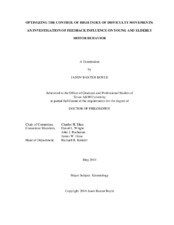| dc.contributor.advisor | Shea, Charles H | |
| dc.creator | Boyle, Jason B | |
| dc.date.accessioned | 2015-01-09T19:58:03Z | |
| dc.date.available | 2016-05-01T05:30:59Z | |
| dc.date.created | 2014-05 | |
| dc.date.issued | 2014-01-15 | |
| dc.date.submitted | May 2014 | |
| dc.identifier.uri | https://hdl.handle.net/1969.1/152510 | |
| dc.description.abstract | Three experiments were conducted to not only further the understanding of previously seen enhancements to goal directed movements following sine wave tracking, but also to investigate if this effect is present following training in an active elderly population.
The purpose of the first experiment was to investigate if a template constructed from recorded Fitts target task limb displacement would provide performance enhancements previously seen following sine wave tracking. Participants (master) where either asked to complete 45 acquisition trials of a Fitts target task or track a sine wave template. The recorded displacement of their performance made up the acquisition templates for two other participant (yoked) groups. Following acquisition, all participants were asked to complete 9 trials of a Fitts target task. The results of this study concluded that participants in both the sine tracking groups showed enhanced performance compared to the Fitts groups. Movement time, time to peak velocity, and endpoint variability were similar for the two sine groups indicating not only faster but more harmonic motion than for the Fitts groups that practiced under the Fitts conditions.
The purpose of the second experiment was to determine if sine wave tracking with amplitude different from that used on the test will result in equally effective transfer to a Fitts task. Participants were assigned to tracking a sine wave template with amplitudes of 16^(o) or 24^(o) or a Fitts task condition with amplitudes of 16^(o) or 24^(o). Following 45 acquisition trials, all participants were tested under Fitts task conditions with amplitude=16^(o). Results demonstrated that participants who tracked the sine wave templates of 16^(o) and 24^(o) showed enhanced performance and were equally effective in performing the 16^(o) Fitts task.
The purpose of the third experiment was to determine if sine wave tracking in an active elderly population would result in decreased movement time without an increase in error when later transferred to a Fitts target task. Participants (elderly, young) where either asked to complete 45 acquisition trials of a Fitts target task or track a sine wave template. Following acquisition, all participants were asked to complete 9 trials of a Fitts target task. The results of this study concluded that participants in both the sine tracking groups (elderly, young) showed enhanced performance compared to the Fitts groups with respect to their age.
Taken together the present experiments not only adds to the extensive literature related to speed-accuracy trade-offs, but presents a novel approach to re-thinking the way typical motor behavior is enhanced at tasks of higher difficulty now and throughout the lifespan. | en |
| dc.format.mimetype | application/pdf | |
| dc.language.iso | en | |
| dc.subject | Speed-Accuracy Trade-offs | en |
| dc.subject | Aging | en |
| dc.title | Optimizing the Control of High Index of Difficulty Movements: An Investigation of Feedback Influence on Young and Elderly Motor Behavior | en |
| dc.type | Thesis | en |
| thesis.degree.department | Health and Kinesiology | en |
| thesis.degree.discipline | Kinesiology | en |
| thesis.degree.grantor | Texas A & M University | en |
| thesis.degree.name | Doctor of Philosophy | en |
| thesis.degree.level | Doctoral | en |
| dc.contributor.committeeMember | Wright, David L | |
| dc.contributor.committeeMember | Buchanan, John J | |
| dc.contributor.committeeMember | Grau, James W | |
| dc.type.material | text | en |
| dc.date.updated | 2015-01-09T19:58:03Z | |
| local.embargo.terms | 2016-05-01 | |
| local.etdauthor.orcid | 0000-0001-6308-0616 | |


